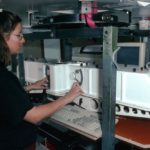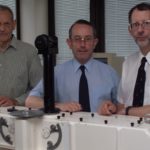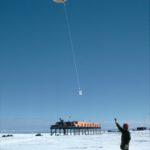25th Anniversary of the Discovery of Ozone Hole
This week British Antarctic Survey (BAS) commemorates the 25th anniversary of one of its most dramatic scientific discoveries — the ozone hole.
In May 1985 reporting in Nature Joe Farman, Brian Gardiner and Jonathan Shanklin described their observations of large losses of ozone over Antarctica. In this week’s Nature Jonathan Shanklin reflects on how the discovery was made and what lessons were learnt.
As part of the anniversary commemorations Jonathan Shanklin appears alongside Nobel Prize winner Paul Crutzen and leading US scientists David Fahey and Susan Solomon at a special international symposium organised by Cambridge University on Friday 7 May. The event will be web cast live at Antarctic Ozone Hole: Then and Now on the website of the European Ozone Research Coordinating Unit
The discovery of the ozone hole alerted the world to the dramatic and major environmental threat. The accumulation of chlorofluorocarbons (CFCs) used in refrigeration and air conditioning systems, and industrial solvents were found to deplete the protective layer of ozone that surrounds the Earth. Action by governments around the world led to the 1987 Montreal Protocol and its amendments, which ensured that production and consumption of CFCs, halons and carbon tetrachloride were phased out by 2000, and methyl chloroform by 2005. All members of the United Nations have now signed the Montreal Protocol. Today, scientists predict that Antarctic ozone levels will return to their 1950s levels by about 2080.
Jonathan Shanklin said,
“This discovery was a crucial reminder of the importance in investing in long-term monitoring, but perhaps the most startling lesson from the ozone hole is just how quickly our planet can change.”
To mark the occasion BAS has published a new public information leaflet, The Ozone Hole.
ENDS
Issued by the BAS Press Office:
Heather Martin, Tel: +44 (0)1223 221414; mobile: 07740 822229; email: hert@bas.ac.uk
Linda Capper, Tel: +44 (0)1223 221448; mobile: 07714 233744; email: lmca@bas.ac.uk
BAS scientist contact details:
Jonathan Shanklin, Tel: +44 (0)1223 221482; mobile: 07736 921693; email: jdsh@bas.ac.uk
Notes for editors:
To mark the anniversary, Nature presents the original research paper, along with a collection of related articles that have advanced our understanding of the stratosphere and the ozone layer, or told the story of the discovery. These will be published on the Nature.com website on Wednesday 5th May at 6pm UK time. To request specific papers from the collection, email: press@nature.com
About the symposium
Organised by the Centre for Atmospheric Science at the University of Cambridge, the Symposium on the 25th anniversary of the publication of ‘Large losses of total ozone in Antarctica reveal seasonal ClOx/NOx intercation’ by JC Farman, BG Gardiner and JD Shanklin takes place on Friday 7 May 2010 at the Department of Chemistry, University of Cambridge.
About the ozone hole
The Antarctic ozone hole is caused by chlorine and bromine in the atmosphere, which come from chlorofluorocarbons (CFCs) and halons. The hole itself begins to form when sunlight returns at the end of the Antarctic winter, and reaches its largest extent every September, before disappearing again by mid summer. The amount of ozone overhead should follow a regular seasonal pattern. This is what occurred during the first 20 years of BAS measurements, but by the late 1970s clear deviations were observed. In every successive spring the ozone layer was weaker than before, and by 1984 it was clear that the Antarctic stratosphere was progressively changing.
British Antarctic Survey (BAS), a component of the Natural Environment Research Council, delivers world-leading interdisciplinary research in the Polar Regions. Its skilled science and support staff based in Cambridge, Antarctica and the Arctic, work together to deliver research that underpins a productive economy and contributes to a sustainable world. Its numerous national and international collaborations, leadership role in Antarctic affairs and excellent infrastructure help ensure that the UK maintains a world leading position. BAS has over 450 staff and operates five research stations, two Royal Research Ships and five aircraft in and around Antarctica.
Stunning broadcast-quality footage and stills of Antarctica are available from the BAS Press Office as above.
Paul Crutzen, Mario Molina and Frank Sherwood Rowland were awarded the Nobel Prize for Chemistry in 1995 for their work on ozone depletion.
Related links
Antarctic Ozone Hole: Then and Now’ Webcast



